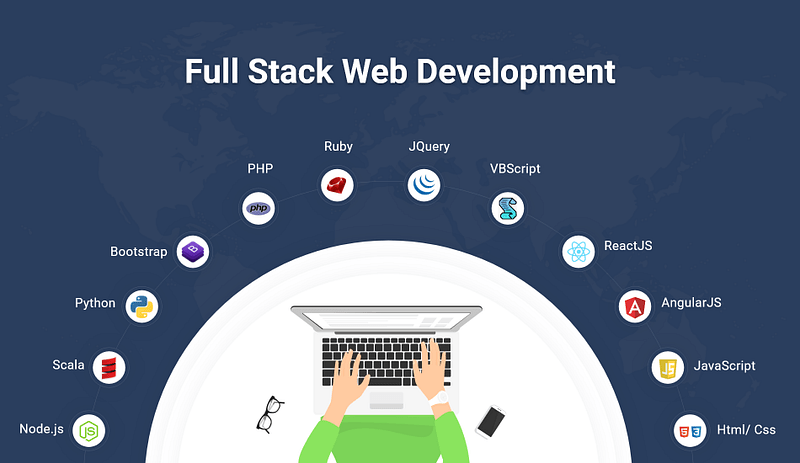Full stack development involves working on both the front-end and back-end of an application, covering everything from databases to user interfaces. Full Stack Development Services are in high demand because they provide a complete solution to building dynamic and responsive web applications. Whether you’re a seasoned developer or just starting, having the right tools and technologies can make a big difference. Let’s explore the top 10 tools and technologies that every full stack developer should know in 2024.
1. React.js
React.js is a popular JavaScript library for building user interfaces, particularly single-page applications. It allows developers to create reusable UI components, making the development process efficient and manageable. React’s virtual DOM feature ensures faster rendering, improving user experience. With a strong community and plenty of resources, React remains a top choice for front-end development in 2024.
2. Node.js
Node.js is a powerful back-end JavaScript runtime environment that allows developers to execute JavaScript code outside a web browser. It’s known for its high performance and scalability, making it ideal for building server-side applications. With a large ecosystem of libraries and tools, Node.js is a favorite among full stack developers who prefer JavaScript for both front-end and back-end development.
3. Angular
Angular is a robust front-end framework maintained by Google. It provides a comprehensive solution for building dynamic web applications. With its two-way data binding and dependency injection features, Angular simplifies complex application development. It’s particularly useful for enterprise-level applications that require a strong structure and high maintainability.
4. Django
Django is a high-level Python web framework that encourages rapid development and clean, pragmatic design. It includes many built-in features, like authentication and an admin panel, that reduce the need for third-party plugins. Django’s “batteries-included” approach makes it a great choice for developers who want a comprehensive, out-of-the-box solution for back-end development.
5. Vue.js
Vue.js is a progressive JavaScript framework that is gaining popularity among developers due to its simplicity and flexibility. It combines the best features of React and Angular, providing a lightweight and easy-to-learn framework. Vue.js is ideal for small to medium-sized projects and is known for its clear documentation and large supportive community.
6. Express.js
Express.js is a minimal and flexible Node.js web application framework that provides a robust set of features for web and mobile applications. It’s often used with Node.js to build server-side applications. Express.js simplifies the process of handling HTTP requests, managing routes, and rendering dynamic content, making it an essential tool for back-end development.
7. MongoDB
MongoDB is a NoSQL database that is well-suited for handling large volumes of unstructured data. Its document-oriented storage model provides flexibility and scalability, making it perfect for applications with evolving data requirements. MongoDB is a popular choice for full stack developers working with JavaScript-based technologies like Node.js.
8. GraphQL
GraphQL is a query language for APIs and a runtime for executing those queries. It allows clients to request specific data, reducing the amount of data transferred over the network. Unlike REST, where you often over-fetch or under-fetch data, GraphQL provides a more efficient way to interact with APIs, making it an excellent tool for optimizing front-end performance.
9. Docker
Docker is a containerization platform that allows developers to package applications and their dependencies into a single container. This ensures consistency across different environments, whether it’s development, testing, or production. Docker helps in streamlining the deployment process and reducing conflicts between teams working on different parts of an application.
10. GitHub
GitHub is a version control platform that helps developers manage and collaborate on code. It provides essential features like pull requests, code reviews, and issue tracking, making it an indispensable tool for both individual developers and teams. With its integration capabilities and vast repository of open-source projects, GitHub is a cornerstone of modern software development.
Conclusion
Full stack development is a dynamic and evolving field, and staying updated with the latest tools and technologies is crucial for success. The right combination of front-end and back-end frameworks, databases, and development tools can greatly enhance your productivity and the quality of your applications. Whether you are building a small startup project or a large enterprise solution, these tools will help you create scalable, efficient, and robust web applications.
FAQs
- What is full stack development?
Full stack development refers to the development of both front-end (client-side) and back-end (server-side) parts of a web application. It involves working with databases, servers, systems engineering, and client-side programming. - Why should I learn full stack development?
Learning full stack development opens up more job opportunities and allows you to understand the entire development process. This makes you more versatile and valuable as a developer. - Which programming languages are best for full stack development?
Common languages include JavaScript (used in frameworks like React, Angular, and Node.js), Python (used in Django), Ruby (used in Ruby on Rails), and PHP. - How long does it take to become a full stack developer?
The time it takes to become a full stack developer varies. For a beginner, it could take anywhere from 6 months to 2 years, depending on the learning pace and the depth of knowledge pursued. - Is it necessary to use all the tools mentioned above for full stack development?
No, it’s not necessary to use all the tools. The choice of tools depends on the project requirements, team preferences, and specific use cases. It’s best to select a stack that suits your project’s needs.
Also Read : Offshore Software Development Firm
